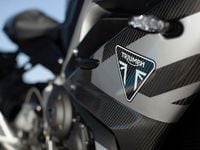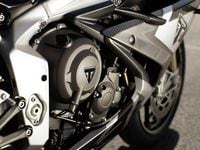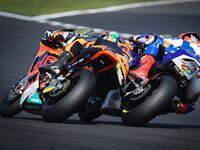The previous highest-spec 765, the Street Triple RS, has an open-deck inline transverse three-cylinder engine with a two-lobe balancer—120-degree triples otherwise rock from side to side—and Nikasil-on-aluminum cylinder walls. A look at the RS’s torque curve shows that, although torque is quoted as peaking at 10,800 rpm, it is only a whisker lower than that down at 9,000 rpm and is nearly constant between those numbers. That tells us this is an acceleration engine. People love big top-end horsepower numbers, but they exist at only one point, way up high. What accelerates a bike is engine performance averaged across the rpm band actually used. Here we see essentially flat torque from 9,000 upward, a torque band so wide that constant skilled stirring of the gearbox is not required.
Strong, wide torque is why Dorna’s technical committee chose this engine to power Moto2 from 2019 onward. They wanted riders to learn to use engine torque as a means of steering, a skill they’ll need when they advance to MotoGP, and that meant there had to be plenty of it.
Triumph could not warranty a streetbike with racebike specs, so performance had to lie somewhere between that of the RS and what Moto2 race teams are getting, which is said to be “more than 138 hp.”
One big change is that streetbikes with two-up seating need a low first gear for uphill stoplights with a friend aboard. That leaves the rider with five closely spaced ratios for riding, plus a low first for starting. Therefore, the Daytona Moto2 765 gets an “all-new” gearbox with “track-optimized” ratios. What this means is that first is made taller so you can actually use it for trackdays and in sporting riding. The Moto2 production model has a “pure single seat.”
Because torque at all rpm can be boosted by higher compression, the Moto2’s compression ratio becomes 12.9:1 rather than the 12.65:1 of the RS.
The Moto2 spec sheet claims 128 hp at 12,250 rpm, a rise of 550 in rpm of peak power. For the RS, that number was 121 hp at 11,700 rpm. Torque for the Moto2 is given as 59 pound-feet at 9,750 rpm, versus the 57 pound-feet produced by the RS at 10,800 rpm.
Where is this extra power coming from? Most of it comes from maintaining the same cylinder filling and combustion at 12,250 rpm rather than the previous 11,700 rpm, with an additional 1 percent coming from a small increase in combustion pressure itself.
No one can make the usual dreary claim that a long stroke is giving these engines their excellent wide, flat torque, for both RS and Moto2 models have a bore and stroke of 77.9mm x 53.4mm, which gives a normal sportbike bore/stroke ratio of 1.46. The bore/stroke ratio of Harley-Davidson’s 114 Big Twin is a very different 0.89!
Okay, if all that torque is not coming from a giant stroke, where does it come from? It comes from three principal features:
Very high compression ratio. Indian's biggest torquer has a 9.5:1 compression ratio, but Triumph's Daytona 765 Moto2 is 12.9:1, which is 36 percent higher.
Using four valves per cylinder instead of the traditional two valves allows this engine to have the shorter valve timings that boost midrange and still make that strong claimed 128-hp peak.
By combining intake ports on the small side with sophisticated port streamlining, intake velocity can be kept high enough in the midrange to fill the cylinders well over a broad range.
Triumph lists other changes made to the new Moto2 model: titanium intake valves (lower weight makes higher revs possible), stronger pistons (I’d bet Triumph did some research here to give the race engines durability and are passing this along), wrist pins coated with Diamond-Like Carbon (DLC), a measure taken to prevent wrist-pin scuffing in high-performance engines. A new cam profile is also listed, but without further information. This could mean either that it gives slightly higher valve lift or that the profile needed refinement to keep the valve train stable at the higher 12,250-rpm redline.
Other parts modified include the intake bell mouths (length is often adjusted to obtain specific torque-curve effects), connecting rods (a different material or heat treat? A slight change in shape to reduce stress concentration?), intake ports, which surely get the airflow treatment for racing use, crankshaft (nature of the change is also not revealed), and cylinder (altered surface finish?).
Sounds like fun to me.














/cloudfront-us-east-1.images.arcpublishing.com/octane/WVYKJFMINVFMFH37AE4OUEWVIM.jpg)

/cloudfront-us-east-1.images.arcpublishing.com/octane/JJ3MC6GNDFF5ZNYD3KD3E4EY7Y.jpg)
/cloudfront-us-east-1.images.arcpublishing.com/octane/XH2ETEU4NVGDFNQO2XT2QQS5LU.jpg)
/cloudfront-us-east-1.images.arcpublishing.com/octane/UFG652C27BDBFPK42TDAJ5CMX4.jpg)
/cloudfront-us-east-1.images.arcpublishing.com/octane/AUE3NFVRRZDSBIDVUGIYIDQNUI.jpg)
/cloudfront-us-east-1.images.arcpublishing.com/octane/LYR62CH2WNBMHJJVXVATZHOUE4.jpg)
/cloudfront-us-east-1.images.arcpublishing.com/octane/RBCTRGBQYBDK7A6XPG3HKPS7ZQ.jpg)
/cloudfront-us-east-1.images.arcpublishing.com/octane/MQXQRYMZVBCWJIRYP3HEN3SHVE.jpg)
/cloudfront-us-east-1.images.arcpublishing.com/octane/TSPODNNEWRDSVJGUCNQTDG4ADI.jpg)
/cloudfront-us-east-1.images.arcpublishing.com/octane/X5TB7BDV4BA2RPSY54ZGK27RP4.jpg)
/cloudfront-us-east-1.images.arcpublishing.com/octane/REUHOJXRDBGZ5IHBYZCCBCISPA.jpg)
/cloudfront-us-east-1.images.arcpublishing.com/octane/52LGJTCKBFEHDF7S7H4CVUIMGM.jpg)
/cloudfront-us-east-1.images.arcpublishing.com/octane/YMWAIPIPSJAOXOU3QMJMGH37OM.jpg)


/cloudfront-us-east-1.images.arcpublishing.com/octane/EJ6KZRGAYBCVXNL2PJXL37UVWQ.jpg)
/cloudfront-us-east-1.images.arcpublishing.com/octane/AAN4TI76M5H5JMUVEIGASWXBDU.jpg)
/cloudfront-us-east-1.images.arcpublishing.com/octane/P3RXD2UCPFF37CMB7CHPVKXORY.jpg)
/cloudfront-us-east-1.images.arcpublishing.com/octane/VZEG2EJI2RDFZNHLRZMU56MD3Q.jpg)
/cloudfront-us-east-1.images.arcpublishing.com/octane/GVJQO5FFOFBWNGODOBRB4FBAW4.jpg)
/cloudfront-us-east-1.images.arcpublishing.com/octane/BIVAK2SFIBDJJM25E7I5VU2FJE.jpg)
/cloudfront-us-east-1.images.arcpublishing.com/octane/CH5VX52UG5CFHOVH5A6UYEFWWA.jpg)
/cloudfront-us-east-1.images.arcpublishing.com/octane/ZVGJNGZRU5C33N7KN23BBFKSC4.jpg)